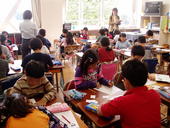Why Singapore’s English Teachers Should Embrace Singlish, Not Fight It
Is it time for Singaporean educators to embrace Singlish as a legitimate learning tool? What the Research […]
Read More
Ms Leong Lai Fong currently teaches at Chongfu Primary School. In 2002, she received the Monbukagakusho Scholarship from the Japanese Government to participate in a teacher-training programme at the Tokyo Gakugei University from October 2002 to March 2004. She shares some of her learning points from this experience.
 One distinctive characteristic of a Mathematics lesson in a typical Japanese elementary classroom is structured problem solving. The central focus of this mode of instruction is the promotion of mathematical thinking, with an emphasis on discussing alternative solutions to a problem.
One distinctive characteristic of a Mathematics lesson in a typical Japanese elementary classroom is structured problem solving. The central focus of this mode of instruction is the promotion of mathematical thinking, with an emphasis on discussing alternative solutions to a problem.
The 50-minute lesson would begin with the teacher presenting the central idea of the day’s lesson, using teaching aids produced either by the teacher or by other teachers in the school. Although commercially produced teaching aids are available, the teachers prefer to produce their own as they can tailor the materials to the needs of their students and at the same time save on costs.
A problem is then posed to the class. In pairs or individually, the students come up with their own solutions to the problem. The teacher does not present an example of the solution to the students prior to giving them the task. While the students are busy solving the problem, the teacher moves about the room giving suggestions or helping those with difficulties.
The class then spends 10 minutes of the lesson presenting their different solutions to the problem. The objective is to expose the students to alternative methods of solving a problem. Presenting an idea, even a wrong one, is strongly encouraged and praised.
The last 5 minutes is then spent with the teacher summing up the lesson and the students writing into their Mathematics journal. The writing and oral presentation together give students training in language skills and logical thinking.
Professor Setzuro Itoh, my supervisor during my one-year research study at the Tokyo Gakugei University, had proposed another approach – task-differentiated lessons for each topic.
Professor Itoh’s task-differentiated method further expands on the existing problem-solving teaching strategy; in the middle of teaching a topic, the teacher hands out a “Readiness Test”. Usually, a few questions on yet-to-be-taught topics are included to identify the high-ability students.
Based on the test results, students then choose which course they would like to attend for the rest of the topic. They make their choices on a “Guidance” questionnaire, in which detailed descriptions of the content of each course are stated. An example of the differences in the three courses under a topic like “Circumference” would be as follows:
As the class works out the solutions, the teacher walks around the class and notes down the progress of each student. When the need arises, a Team Teaching teacher would come in to assist the weaker students.
Professor Itoh has been a long-term consultant to eight elementary schools in both Tokyo and Saitama Prefectures. These “Frontier Schools” were the first batch to try out the method in 2002, and by March 2004, about 63% of all elementary schools in Japan were carrying it out.
This experience has taught me the importance of keeping regular records of each student’s progress in order to cater to his/her needs. Teachers should also assign customised work if the need arises.
The Japanese teachers can achieve this because of several factors, the most significant being small class sizes. The average class size in a Tokyo public school is 20, and the entire school population hovers at around 300. We need much more than the classroom teacher’s effort if we really want to cater to the individual student’s learning needs.